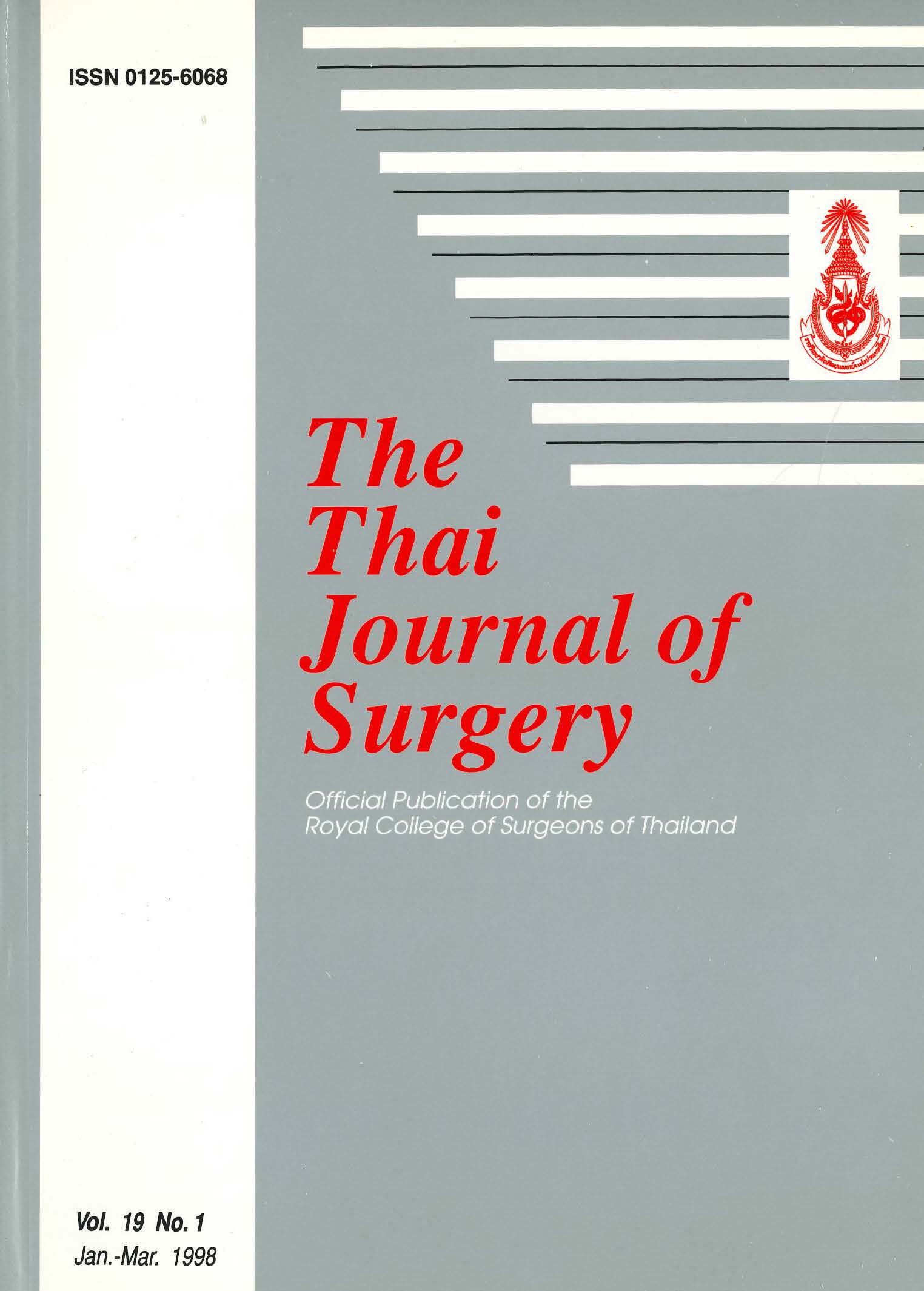Corrosive Acid (Vixol®) Ingestion, Spectrum of Injury and Management
Abstract
A total of 10 patients with definite history of intentional corrosive acid ingestion, during the past 12 years at Taksin Hospital, were reported focussing on the spectrum of injury, recognition of the deep injury and its managemant. Most of the cases (9 out of 1O patients) were esophageal injury. Isolated involvement of esophagus and stomach were present in 3 and 1 patients, respectively. In 6 patients both were damaged. These findings are contrary to the general belief that the esophagus is spared in acid ingestion. The common site of esophageal injury was at 20 and 30 cm. from incisor-and just above esophagogastric junction. Periodic dilatation of esophagus may require more than 2 years in many cases and the outcome of these patients must depend on the compliance of patients and their families. Such compliance problem was overcome after the use of "Soft & Self balloon dilatation" in Taksin Hospital and esophageal reconstructive surgery were avoided in case of multiple sites or long segment stricture. False tract that was recognised during dilatation responded well to conservative treatment. The treatment of choice for pyloric stenosis is Billroth I gastrectomy.
References
2. Sarfati E, Gossot O, Assens P, Celerier M. Management of caustic ingestion in adults. Br. J Surg T987: 74:146-8.
3. Chodak GW, Passaro E Jr. Acid ingestion need for gastric resection. JAMA 1978; 239:225-6,
4. Mc Lanahan S. Pyloric occlusion following the ingestion of corrosive liquids. JAMA 1934; 102:735.
5. Citron BP, Pincus IV, Geokas MD, et al. Trauma of the esophagus and stomach. Surg Clin North Am 1968: 48:1 ,303.
6. Nicosia JF, Thornton JP, Folk FA, Saletta JD. Surgical management of corrosive gastric injuries. Ann Surg 1974: 180:139-43.
7. Maull KI, Scher LA, Greenfield Lu. Surgical implications of acid ingestion. Surg Gynecol Obstet 1979; 148:895-8.
8. ZargarSA, Kochhar R, Nagi B and et al. Ingestion of corrosive acids. Spectrum of injury to upper gastrointestinal tract and natural history. Gastroenterology 1989; 97:702-7.
9. Chanvitan A, Nimitpanpong P, Puttavibul P, Esophagealscarring and its relationship with the treatment of acid corrosive esophagitis. J Med Assoc Thai 1988; 71:376-81.
10. Dilawari JB, Singh S, Rao PN, Anand BS. Corrosive acid ingestion in man: a clinic al and endoscopic study. Gut 1984; 25:183-7.
11.Testa GF. Contrilreta Radiologica e Sperimentale alla Studio dell Lesione Esofagee e Gastriche nelle Causticazioni da Alacali. Radiol Med Torina 1938: 25:17
12. Karon AB, Wall HC, Pyloric stenosis caused by the ingestion of a corrosive acid simulating gastric carcinoma: Report of a case. Gastroenterology 1951; 17:445.
13. Marks IN, Banks MB, Werbeloff L, Forman MB, Louw JH. The natural history of corrosive gastritis : Report of five cases. Am J Digest Dis 1963; 8:509.
14. Nevin IN, Turner NW, Gardner HT, Early and late roentgenographic findings in corrosive gastritis, Am J Roent 1959; 81:603
15. O'Donnell CH, Abbott WE and Hirchfeld JW. Surgical treatment of corrosive gastritis. Am J Surg 1949; 78:251.
16. Eaton H, Tennekoon GE. Squamous carcinoma of the stomach following corrosive acid burns. Br J Surg 1972; 59:382.
Downloads
Published
How to Cite
Issue
Section
License
Articles must be contributed solely to The Thai Journal of Surgery and when published become the property of the Royal College of Surgeons of Thailand. The Royal College of Surgeons of Thailand reserves copyright on all published materials and such materials may not be reproduced in any form without the written permission.



